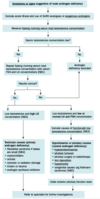Sexual + Reproductive Health Flashcards
(236 cards)
What proportion of couples experience infertility?
15%
What is the definition of infertility?
- failure to achieve pregnancy within 12 months of regular unprotected intercourse in women aged <35 - or within 6 months in a women aged > 35
Clinical factors which increase risk of subfertility
- oligomenorrhoea - amenorrhoea - known or suspected peritoneal disease - severe endometriosis - multiple surgeries - loss of an ovary - previous chemotherapy or radiotherapy
Which hormone should be tested for if ovulation is uncertain?
- serum progesterone should be performed mid-luteal phase (seven days before next expected menses)
What history would confirm ovulatory cycles?
- history of regular cycle intervals of between 21-35 days with consistent characteristics and moliminal symptoms - in these patients serum progesterone is not required to confirm ovulation
Which investigations should be undertaken for women with oligo/amenorrhoea?
- FSH - LH - oestradiol (E2) - TSH - prolactin
Which blood tests should be ordered in suspected PCOS?
- free testosterone, free androgen index, DHEAs - need to rule out non-classical congenital adrenal hyperplasia with 17-hydroxyprogesterone concentration - in cases of severe hyoerandrogenism consider excluding Cushing’s disease
Ovarian reserve testing
- quantity and quality are both important factors! - oocyte number peaks at 20 weeks gestation, this declines throughout reproductive life resulting in menopause - routine markers: day 2-4 FSH, E2, AMH and assessment of antral follicle count on TV ultrasound - provides information r.e. predicted response to assisted reproductive treatment - does not predict spontaneous conception!
Day 2-4 (basal) FSH as measure for ovarian reserve
- indirect marker of ovarian reserve - based on feedback inhibition of pituitary FSH secretion - if diminished ovarian reserve ovarian steroidogenesis will be insufficient to suppress early follicular FSH - measurement of E2 increases FSH sensitivity - E2 will be raised with low ovarian reserve due to increased FSH but causes pituitary FSH suppression meaning FSH falls within normal range
Where is AMH produced?
- by granulosa cells of the pre-antral and antral follicles - hence reflexes the size of primordial follicle pool - serum AMH concentration is inversely related to age - can be tested on any day of cycle
Antral follicle count on US as measure for ovarian reserve
- total number of follicles in both ovaries with mean withdth of 2-10mm on USS - assessment in early follicular phase avoids underestimation of follicular number
Which USS features are suggesting of andemomysos?
- venetian blind shadowing - globular uterine appearance - loss of junctional zone definition - “question mark sign”
What are the recommended preliminary fertility investigations?
- day 2-4 FSH, LH, oestradiol - AMH - TSH - transvaginal USS with AFC and anatomy and to check for deep infiltrating endometriosis - blood group and antibody screen - rubella and varicella igG - hep b/c/HIV/syphilis serology=
How long should women defer contraception for after rubella or varicella immunisation?
28 days
What is the most important determinant for women considering oocyte cyropreservation?
AGE! Infertility is most common in >35 year age group - frozen eggs have survival rates of >84% compared to IVF
How long should women defer contraception for after rubella or varicella immunisation?
28 days
What is the most important determinant for women considering oocyte cyropreservation?
AGE! Infertility is most common in >35 year age group - frozen eggs have survival rates of >84% compared to IVF
Which forms of contraception are first line options 0-6 week post partum (breast feeding or not)?
Implanon and POP
Which form of contraception is generally recommended to be avoided in smokers?
COCP - contraindicated in women > 35 who are smoking > 15 cigarettes/day (cat 4) - however still increased risk if smoking <15/day or have quit smoking for <1 year (cat 3) - if have quit for > 1 year (cat 2) - women < 35 and smoking (cat 2)
What are the categories for contraception in patients with previous VTE?
Copper IUD = cat 1 Mirena/implanon/depot/POP = cat 2 COCP = cat 4
When is the COPC contraindicated in patients with HTN?
- sustained BP > 160/ > 100 = cat 4 - BP 140-159/90-99 OR even if hypertension is well managed COPC is still cat 3
What are the categories for contraception in patients with previous VTE?
Copper IUD = cat 1 Mirena/implanon/depot/POP = cat 2 COCP = cat 4
What category is the COCP in patients with migraine with aura?
CAT 4!
What are the categories in patients with a history of breast cancer?
Copper IUD = cat 1 Current breast cancer = any hormonal contraception is cat 4 Past breast cancer = any hormonal contraception is cat 3







